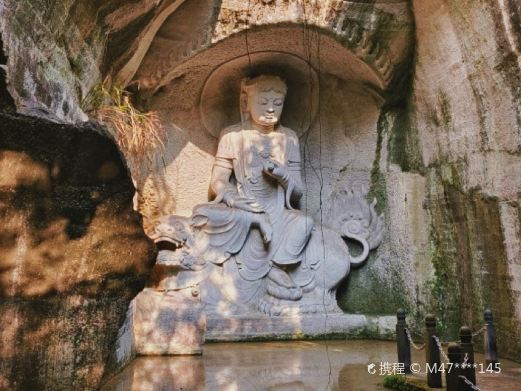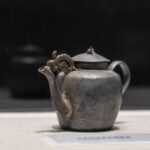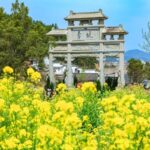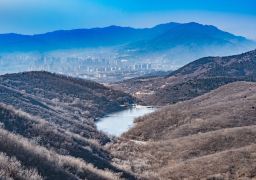The Thousand Buddhas Zen Temple, originally known as the Yuanhua Temple, was founded by the distinguished monks Yu Falan and Yu Fakai. It shares the same era with the First Great Buddha of the South of the Yangtze River, being another grotto constructed during that time. The grotto’s construction commenced in the third year of the Yongming era of the Qi Dynasty (AD 485), which was a year before Monk Sheng Hu arrived in Shicheng. Upon completion, the temple was renamed to its current title, only to be destroyed during the Huichang period. It was later reconstructed in the third year of the Kaiyun era of the Later Jin Dynasty (AD 946).

During the Dazhong Xiangxiang era of the Song Dynasty, the temple was renamed to the Qi Bao Temple. However, in the fifteenth year of the Hongwu era of the Ming Dynasty (AD 1382), it was renamed back to the Thousand Buddhas Zen Temple.
Nestled in the lush forests and bamboo groves on the hillside, the Thousand Buddhas Zen Temple faces south towards a cliff and comprises two interconnected caves of varying sizes. The larger cave is segmented into 10 sections on the east and 6 on the west, each with a 10×11 grid pattern. Each grid contains a Buddha statue, with the middle nine grids combined into one large grid featuring a larger Buddha statue. This results in 104 Buddha statues per section, totaling 1040 statues across all sections. Flanking these are two guardian bodhisattvas standing on lotus seats. Although their external shapes have been altered, the original forms have been revealed as the external coatings have peeled away.The Thousand Buddhas Zen Temple is a site of significant cultural value, comparable to the renowned Yungang and Longmen Grottoes. The statues within are adorned with treasure ribbons draped over their shoulders, and silks crossing their chests and waists. Some are dressed in the style of the Southern Dynasties, which is quite rare among southern grotto statues.
In the smaller cave, there are 35 stone statues. Scholars suggest that these represent the evolution of the Buddha’s teachings from 35 Buddhas to 53 Buddhas, ascending through three kalpas, also known as the Thousand Buddhas. The ‘Bead Leaves’ document this transformation, and the temple’s images reflect this belief. The Buddha statues in the two caves symbolize the three periods—past, present, and future—as well as the ten directions—up, down, left, and right—signifying that all Buddhas are encompassed within. These statues have been recognized in the ‘Chinese Encyclopedia’ and included in the ‘World Art Collection: Southern and Northern Dynasties Volume’, a publication by China and Japan.
A related legend tells of the eminent monk Bo Seng Guang, who, seeing the connected peaks and deep valleys as an ideal Buddhist land, decided to carve a large Buddha. The task took two generations to complete. In the third generation, he was reincarnated as a monk on Nanming Mountain and continued the carving of the great Bodhisattva. This story moved the gods, who sent more than 1000 heavenly soldiers and generals to Nanming Mountain to aid him in his endeavor.Eventually, the stone Maitreya statue was completed. After helping Bo Seng Guang carve the great Bodhisattva, these heavenly soldiers and generals fell in love with the human world and refused to return to heaven. They all went to a temple grotto outside the Dafo Temple gate. When Bo Seng Guang caught up, he found that these people had all turned into small Buddhas, sitting neatly on the walls of the grotto. Later generations called this place the ‘Thousand Buddhas Cave’. At the entrance of the cave, there is a newly piled ‘Island Guanyin’ sculpture moved from Yin Yue Cave. The entire text is open all year round from 07:00 to 17:00. The specific business status is subject to the actual opening situation of the day.









